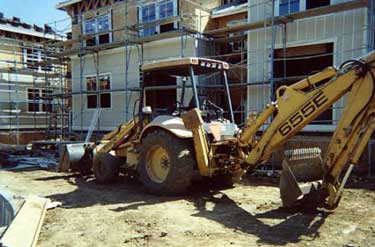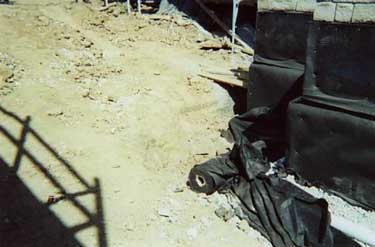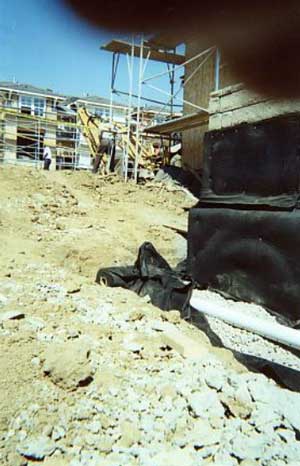A Backhoe Operator Died When His Backhoe Pinned Him Against a Retaining Wall
California Case Report: 05CA001
Summary
A 38-year-old Hispanic equipment operator died when he was pinned against a retaining wall by the front bucket of his backhoe after he got off it to unload the front bucket with a shovel. The victim had set the backhoe brake, but the brake failed to hold the backhoe in place. The backhoe was on an incline, and the wheels were not chocked to hold the backhoe in place. The victim had a load of rock and gravel in the backhoe bucket that he had elevated before he got off the backhoe. The CA/FACE investigator determined that in order to prevent future occurrences, employers, as part of their Injury and Illness Prevention Program (IIPP), should:
- Ensure employees lower the loader and backhoe buckets to the ground when parking a backhoe unattended on an incline.
- Ensure employees block and/or chock the backhoe wheels when parked unattended on an incline.
- Ensure employees are trained on equipment operation and safety, and their achievement of skills is verified through a testing program.
Introduction
On March 14, 2005, at approximately 8:00 a.m., a 38-year-old Hispanic equipment operator died when he was pinned against a wall by the front bucket of a backhoe tractor. The CA/FACE investigator learned of this incident on April 17, 2005, through the Los Angeles County Coroner’s post mortem report. Contact with the victim’s employer was made on May 17, 2005. On May 31, 2005, the Ca/FACE investigator traveled to the facility where the victim had been employed and interviewed the company’s president. He later interviewed coworkers by phone.
The employer of the victim was a family-owned general contracting business that specialized in excavation, shoring, and trenching. The company had been in business for over 40 years and had 30 employees. There were four employees of the company at the site where the incident took place. The victim had been employed with the company for three years as a laborer and equipment operator. The victim was born in Guatemala. According to his employer, the victim had been in the United States for 12 years and spoke both English and Spanish. The victim’s direct supervisor, other supervisors, and co-workers also spoke Spanish.
The company had a written safety program printed in English. The program had generic procedures that were not task-specific for employees to follow. Safety meetings were held monthly and were documented. The company did not have a training program that provided specific training for the machines being operated. According to the company president, they tried to hire people with prior experience. There was no documentation available to determine the level of training or experience the victim had prior to his employment with the company. According to the employer, the victim had demonstrated his skills in operating the backhoe when he was hired and had operated the backhoe without incident on a regular basis until the day of the incident.
Investigation
The site of the incident was a construction site of a housing complex. Behind a building under construction was a retaining wall which was 6½ feet high. At the bottom of the wall was a two-foot drainage ditch with a pipe that was to be covered with gravel and rock and then wrapped with landscaping fabric and backfilled. The machine involved in the incident was a backhoe tractor that was 24 feet long and weighed more than 14,000 pounds. The backhoe was equipped with a 1.3 cubic yard loader bucket, and a 24-inch heavy duty backhoe bucket. The parking brake was a disc on the transmission output shaft that was mechanically activated with a hand lever located on the right side of the operator’s seat.
The victim, who was the operator of the backhoe, was bringing rock and gravel to be unloaded in the trench. He drove the backhoe to the trench and then parked it so the front bucket was at the end of the trench. The backhoe was on an incline that measured approximately 20 degrees. As the victim got off the backhoe, he left the front bucket that was full of rocks and gravel elevated, and set the parking brake. The victim and a co-worker used shovels to scoop the gravel and rock out of the bucket and then spread it over the pipe in the trench. The victim then began to lay down the landscaping fabric over the gravel and rock. He was bent over directly in front of the backhoe bucket when the backhoe started rolling forward and pinned the victim against the retaining wall. Another worker got on the backhoe and moved it in reverse to release the victim. This worker told the police that the backhoe’s parking brake was engaged and the gear shifter was in 1st gear. A check of the parking brake showed that it was operational. The victim’s supervisor was in the area but not within visual distance of the incident when it occurred. The paramedics were called and they treated the victim at the scene, and then transported him to a local hospital where he died from his injuries.
Cause of Death
The cause of death, according to the death certificate, was multiple traumatic injuries.
Recommendations/Discussion
Recommendation # 1: Ensure employees lower the loader and backhoe buckets to the ground when parking a backhoe unattended on an incline.
Discussion: When parking a backhoe, it is recommended that the operator select level ground whenever possible, engage the parking brake, lower the loader and backhoe buckets, shift all controls to neutral, idle then shut off the engine, remove ignition key, and block and/or chock the wheels. When the backhoe has to be parked on an incline, then every effective mechanical means to prevent the backhoe from moving downward must be taken. The lowering of the loader and backhoe buckets is one way to effectively prevent the backhoe from moving. When the buckets are lowered to the ground, they act like a barricade because the weight of the buckets creates drag to help prevent the backhoe from moving, even on an incline. When backhoe operators perform this precautionary function each and every time they get off their tractor, incidents such as this one could be prevented. Employers can enhance worker compliance with safe work practices through programs of task specific training, supervision, recognition, and progressive disciplinary measures.
Recommendation #2: Ensure employees block and/or chock the backhoe wheels when parked unattended on an incline.
Discussion: Even when the parking brake is applied, equipment can move if there is not enough pressure applied. The manufacturer of the backhoe stated in its operators’ manual that the parking brake was not designed to hold the backhoe in place when parked unattended on an incline. When equipment parked on inclines has the wheels chocked and the parking brake set, it is prevented from moving by effective mechanical means. Had the victim chocked the backhoe wheels, it would have prevented it from moving forward on the incline and this incident might have been prevented.
Recommendation #3: Ensure employees are trained on equipment operation and safety, and their achievement of skills is verified through a testing program.
Discussion: The employer of the victim did not have any training program to ensure the operators had all the necessary safety knowledge as well as operating knowledge to operate the equipment. Even though the victim demonstrated an ability to operate the backhoe, it is not known whether he knew of all the safety features and precautions that are associated with the backhoe. A testing program would assure employers that employees are not only qualified in the backhoe operation, but also knowledgeable of all the backhoe’s safety features and their limitations. Had such training been made available for this employee, this incident might have been prevented. Employers can enhance worker compliance with safe work practices through programs of task-specific training, supervision, recognition, and progressive disciplinary measures.
References
- California Code of Regulations, Vol. 9, Title 8, Sections 1593(h).
- Association of Equipment Manufacturers SAFETY MANUAL, Backhoe/Loader, 2001.
- http://www.trentonford.com/nhbackhoe.htm (Link no longer available 3/20/2008)
Exhibits

|
|
Exhibit 1. The backhoe involved in the incident.
|

|
|
Exhibit 2. The area where the incident took place, depicting the angle of the slope the backhoe was parked on.
|

|
|
Exhibit 3. A view of the retaining wall and the slope of the surface where the backhoe was parked when the incident occurred.
|
California Fatality Assessment and Control Evaluation (FACE) Project
The California Department of Health Services, in cooperation with the Public Health Institute and the National Institute for Occupational Safety and Health (NIOSH), conducts investigations on work-related fatalities. The goal of this program, known as the California Fatality Assessment and Control Evaluation (CA/FACE), is to prevent fatal work injuries in the future. CA/FACE aims to achieve this goal by studying the work environment, the worker, the task the worker was performing, the tools the worker was using, the energy exchange resulting in fatal injury, and the role of management in controlling how these factors interact. NIOSH-funded, state-based FACE programs include: Alaska, California, Iowa, Kentucky, Massachusetts, Michigan, Minnesota, Nebraska, New Jersey, New York, Oklahoma, Oregon, Washington, West Virginia, and Wisconsin.
To contact California State FACE program personnel regarding State-based FACE reports, please use information listed on the Contact Sheet on the NIOSH FACE web site. Please contact In-house FACE program personnel regarding In-house FACE reports and to gain assistance when State-FACE program personnel cannot be reached.
